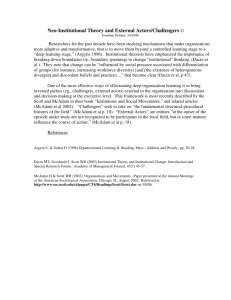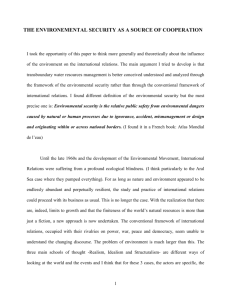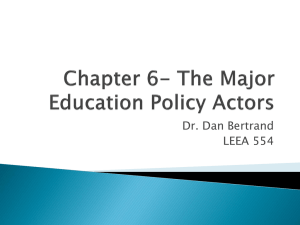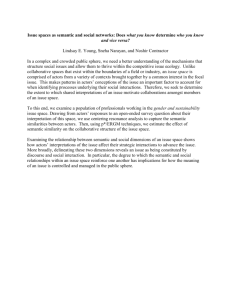The Evolution of an Organizational Field: The
advertisement
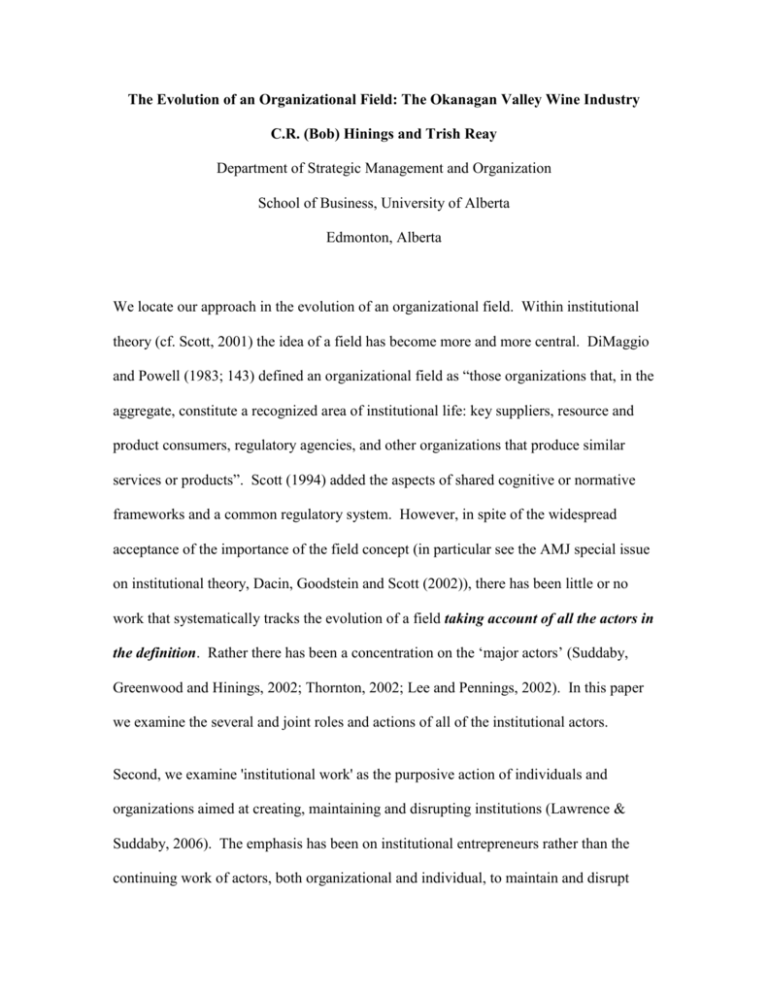
The Evolution of an Organizational Field: The Okanagan Valley Wine Industry C.R. (Bob) Hinings and Trish Reay Department of Strategic Management and Organization School of Business, University of Alberta Edmonton, Alberta We locate our approach in the evolution of an organizational field. Within institutional theory (cf. Scott, 2001) the idea of a field has become more and more central. DiMaggio and Powell (1983; 143) defined an organizational field as “those organizations that, in the aggregate, constitute a recognized area of institutional life: key suppliers, resource and product consumers, regulatory agencies, and other organizations that produce similar services or products”. Scott (1994) added the aspects of shared cognitive or normative frameworks and a common regulatory system. However, in spite of the widespread acceptance of the importance of the field concept (in particular see the AMJ special issue on institutional theory, Dacin, Goodstein and Scott (2002)), there has been little or no work that systematically tracks the evolution of a field taking account of all the actors in the definition. Rather there has been a concentration on the ‘major actors’ (Suddaby, Greenwood and Hinings, 2002; Thornton, 2002; Lee and Pennings, 2002). In this paper we examine the several and joint roles and actions of all of the institutional actors. Second, we examine 'institutional work' as the purposive action of individuals and organizations aimed at creating, maintaining and disrupting institutions (Lawrence & Suddaby, 2006). The emphasis has been on institutional entrepreneurs rather than the continuing work of actors, both organizational and individual, to maintain and disrupt institutions on an ongoing basis. By taking account of all actors in a field we start from the possibility of both collaboration and competition between them, deriving from different interests, values and institutional resources. Thus, institutional work takes place both to maintain the field and also to disrupt it, at the same time. Our aim is to depict the ways in which a variety of actors, both organizational and individual, act in the ongoing work of institutional operation. Third, we examine institutional work within a field that has evolved rapidly over the recent past, something that allows a clearer view of the role of different actors. In the past 20 years, and, in particular over the past 10 years, the wine industry in the Okanagan Valley, British Columbia, Canada has been such a field. This is an ‘immature’ field in which institutionalized practices are still being established. In such a field it is possible to see active agency at work in creating, maintaining and challenging emerging practices. This possibility is also enhanced through the presence of strong regulators (e.g., the provincial government, the BC Wine Authority), a wide variety of producers (e.g., small, family owned wineries, large, international, wine companies, medium-sized corporate players, grape growers), industry associations, a wide variety of suppliers and customers, and a strong role for both educational institutions (e.g., UBC, Brock University, Okanagan College) and tourism associations and wine writers. We examine the roles of the various actors and the activities they engage in to create and resist emerging institutional practices. References Dacin, T., Goodstein, J. & Scott, W.R. 2002. Institutional theory and institutional change: introduction to the special research forum. Academy of Management Journal, 45: 45-57. DiMaggio, P. & Powell, W.W. 1983. The iron cage revisited: institutional isomorphism and collective rationalities in organizational fields. American Sociological Review, 48: 147-160. Lawrence, T. & Suddaby, R. 2006. Institutional work. S. Clegg, C. Hardy & T. Lawrence (eds.), Handbook of Organization Studies. London: Sage. Lee, K. & Pennings, J. 2002. Mimicry and the market: adoption of a new organizational form. Academy of Management Journal, 45: 144-162. Scott, W.R. 1994. Conceptualizing organizational fields: linking organizations and societal systems. In H.U. Derlien, U. Gerhardt & F.W. Scharpf (eds.), Systemrationalitat und partialinteresse. Baden Baden, Germany: Nomos Verlagsgesellschaft. Scott, W.R. 2001. Institutions and organizations. Thousand Oaks, CA: Sage. Suddaby, R., Greenwood, R. & Hinings, C.R. 2002. Theorizing change: the role of professional associations in the transformation of institutionalized fields. Academy of Management Journal, 45: 58-80. Thornton, P. 2002. The rise of the corporation in a craft industry: conflict and conformity in institutional logics. Academy of Management Journal, 45: 81-100.

